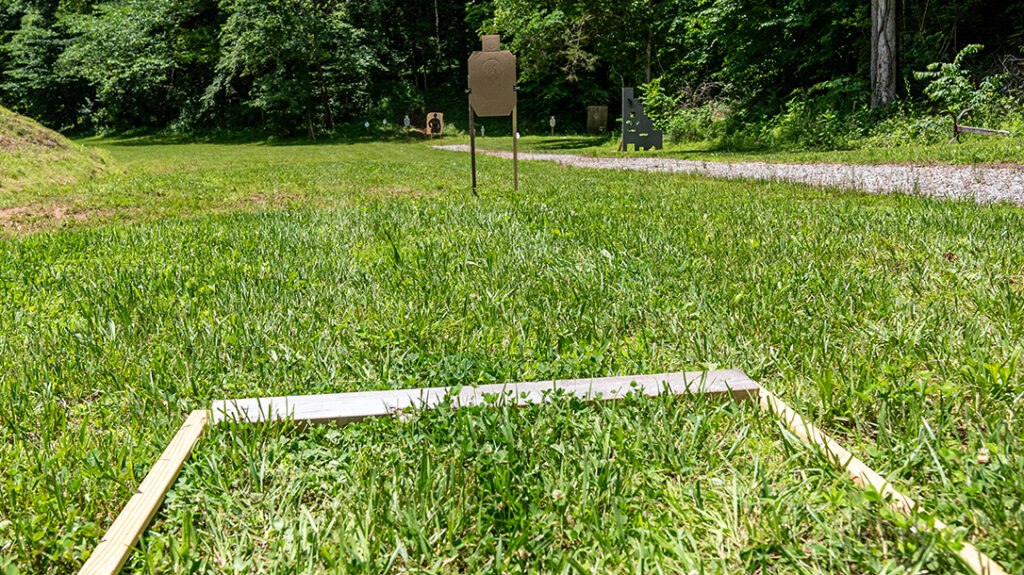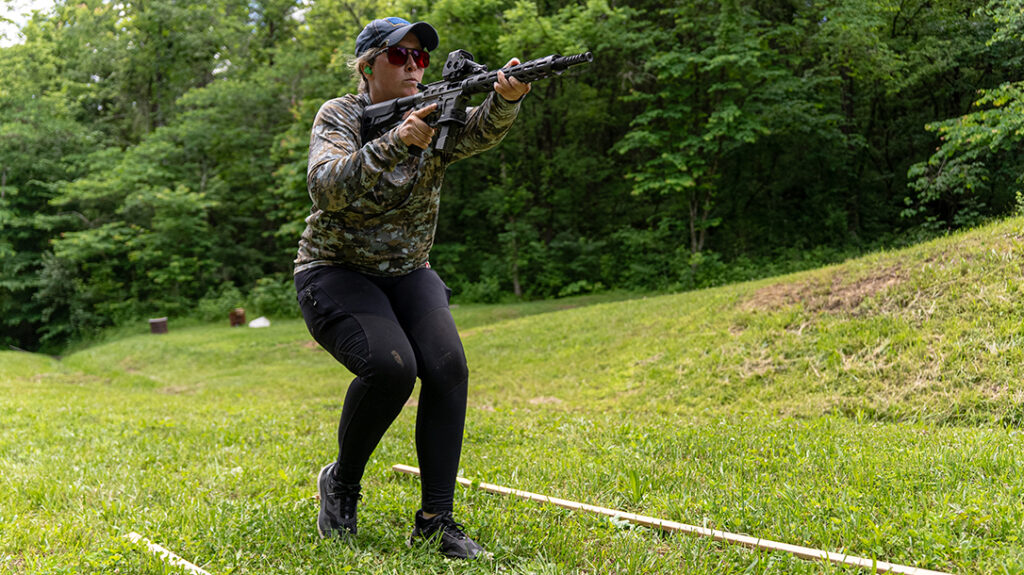The world of competitive shooting revolves around movement, and before working on shooting while moving, we need to master the art of carbine entries and exits. Most shooters who haven’t fired a gun at targets while walking or running will focus on shooting from one position to the next. When entering a shooting position, you want to minimize the time it takes to get into position, raise your gun, and start shooting. This drill will show you the value of mastering your entries to cut down on lost time.
Training 101: Carbine Entries
Equipment Needed
- Carbine (TTI TR-9 PCC)
- Ammunition
- Paper Target
- Shooting Box (I laid out the box using wooden target sticks, but you can also use spray paint.)

Advertisement — Continue Reading Below
The Drill
The drill sounds simplistic, and it is, but there are small details to work on in this drill. The start position is outside the shooting box with your carbine pointed at the low ready. When ready, run into the shooting box, have your firearm raised up before reaching the end of the box, and fire two shots as you come to a standstill. These shots must land in the A zone of a USPSA target, the Down Zero zone of an IDPA target, or the center mass of any other style target.
How to Make an Entry
Footwork is one of the first things you need to work on, as it is the foundation of this drill. You should be in an all-out run at the start of the drill. You should begin smaller, shuffle steps almost midway through the shooting box as you start to slow yourself down. At the end of the box, your knees should remain bent with your hips angled toward your target. Once at a complete stop, you should be in a natural, stable, wide shooting stance. You don’t have the footwork down if you overshoot the box by not slowing down before reaching the end. If you take small shuffle steps the whole way into the box, you are losing valuable time and defeating the drill’s purpose.
The next thing to focus on is what happens to the carbine as you’re running, slowing down, and approaching the end of the shooting box. It is more challenging to move with any long gun, whether it be a carbine or shotgun, than with a handgun. There is a very important 180-degree rule in any shooting competition where your muzzle cannot go past the invisible 180-degree line for safety purposes.
Advertisement — Continue Reading Below
The best way to move forward with a carbine is to move it like a pump-action shotgun. With both hands on the carbine, pump the gun up and over your dominant side shoulder and then push the whole gun forward as you run. Your gun will be somewhere around a 45-degree angle as you run, with the muzzle never pointing straight down at your toes or completely left or right (all you left-handed shooters). Do this during your all-out sprint at the beginning of the drill.

Slow & Smooth in the Middle
As you slow down in the middle of the shooting box, you should start to shoulder the carbine. This middle part is the most crucial part of the drill. If you get to the end of the box and are at a standstill before you start shooting at the target, you’re shooting too late. The goal of the entry is to have the gun up, shouldered, aimed at the exact spot on the target you want to impact, and have the trigger prepped before coming to a halt. As soon as you’re at the end of the shooting box, finalizing your stable shooting stance, you should be making your two shots on target.
Advertisement — Continue Reading Below
I mentioned that the shots in this drill need to hit a goal zone of center mass. If they are outside of this zone, you need to assess your target to determine how to correct your shot. If they are low, you might not have the gun raised up high enough before pulling the trigger. When rounds hit left or right of the target, you could not have the gun shouldered properly, your hips turned toward the target, or you could be pushing the gun sideways with your support hand.
Why the Carbine Entries Matter
If you learn to master the entry, you will be set up for success when learning how to shoot while moving. Without a stable entry position, you can then proceed to fumble the exit if you have a secondary shooting area from which to shoot. When you begin to add vision barriers to drills, such as barrels or walls, it is crucial to have the entry down.
With a vision barrier, you want to have the gun up and ready to fire as soon as you land in your entry position. If you know the targets are behind the vision barrier and the spot you need to land in, you can have the gun up and trigger prepped while slowing down. Then, as soon as you are close to the shooting position and finalizing your shooting stance, you can begin firing your carbine at the targets. Master your entries, and then work on leveling up!
Advertisement — Continue Reading Below





















